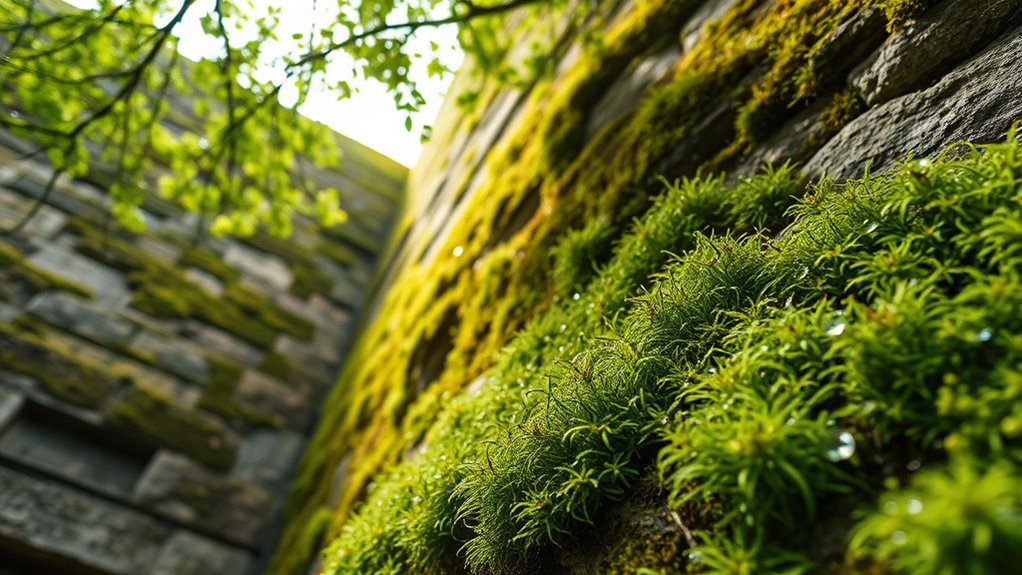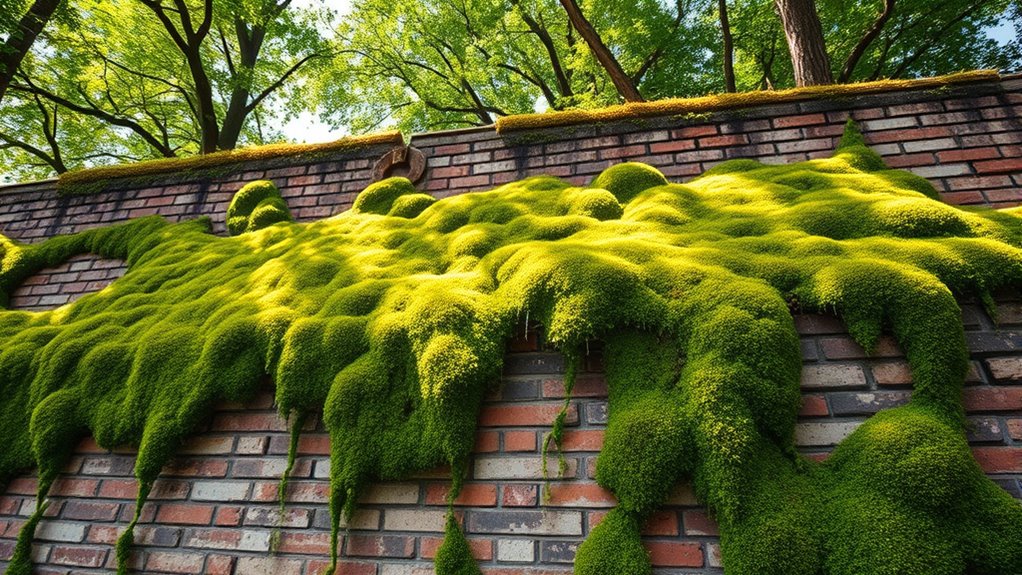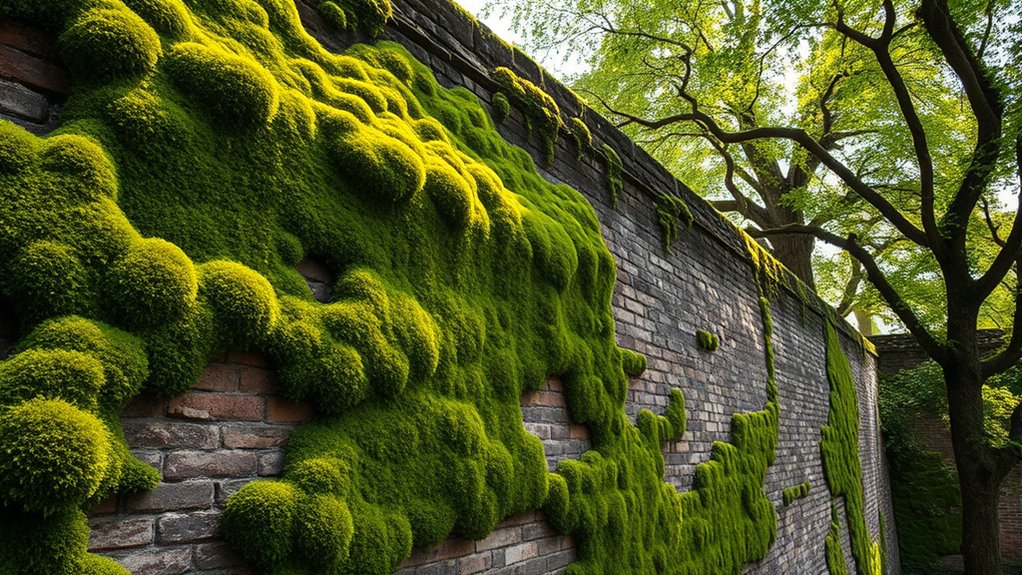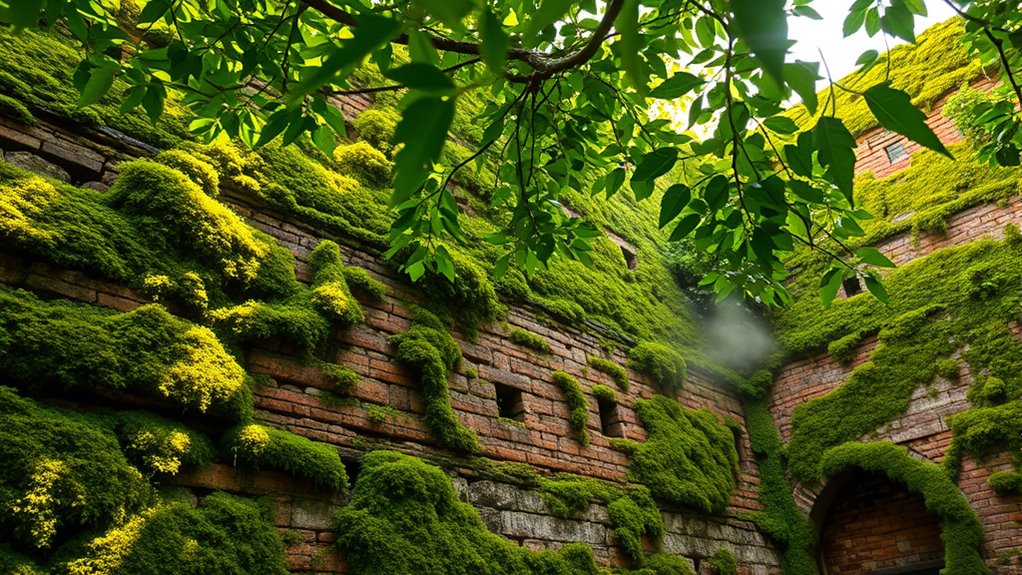Moss-covered city walls naturally filter pollution by absorbing airborne toxins like nitrogen oxides and particulate matter through their leaves and stems, without needing energy or chemicals. These living structures improve air quality, support biodiversity, and add aesthetic appeal to urban spaces. Cities worldwide, like Milan and Singapore, incorporate moss walls to create healthier, greener environments. To learn how you can implement and maintain these eco-friendly walls effectively, explore the innovative ways moss serves as a living pollution filter.
Key Takeaways
- Moss walls absorb pollutants like nitrogen oxides and particulate matter through biological processes, naturally filtering urban air.
- They enhance city aesthetics while providing ecological benefits such as supporting biodiversity and urban habitats.
- Proper installation and maintenance, including watering and pruning, ensure moss walls remain effective pollution filters.
- Cities globally, including Milan and Singapore, utilize moss-covered walls to improve air quality and promote green urban spaces.
- Advances in technology and design are improving the durability, efficiency, and aesthetic appeal of moss-based pollution filtering walls.
The Science Behind Moss as a Natural Air Filter

Mosses are remarkable natural air filters because they can absorb pollutants directly through their leaves and stems. This process, known as moss bioremediation, allows mosses to capture airborne contaminants like nitrogen oxides and particulate matter efficiently. Unlike traditional filtration systems, mosses don’t require energy or chemicals; they rely solely on their biology to improve air quality. When integrated into urban greenery, moss walls and mats act as living air purifiers, reducing pollution levels in busy city environments. Their high surface area and porous structure enable them to trap pollutants effectively, making them a sustainable solution for improving air quality. Additionally, the porous structure of mosses facilitates gas exchange, enhancing their ability to absorb pollutants from the air. By harnessing moss bioremediation, you can transform urban spaces into cleaner, healthier environments naturally.
Benefits of Implementing Moss Walls in Urban Environments

Implementing moss walls in urban environments offers a range of significant benefits, especially in improving air quality and enhancing city aesthetics. Moss walls naturally filter pollutants, reducing airborne toxins and creating healthier urban spaces. They also boost ecological benefits by supporting biodiversity and increasing greenery in concrete-dominated areas. Additionally, moss walls improve urban aesthetics, making cityscapes more inviting and vibrant. The table below highlights key advantages:
| Benefit | Impact | Example |
|---|---|---|
| Air purification | Removes pollutants | Cleaner air in city centers |
| Ecological support | Supports biodiversity | Habitats for small organisms |
| Visual appeal | Beautifies urban landscapes | Green, natural walls |
Furthermore, color accuracy plays a crucial role in how visually appealing and realistic these moss walls appear, enhancing their overall aesthetic value.
Successful Examples of Moss-Covered Walls Around the World

Around the world, several projects showcase the remarkable potential of moss-covered walls to transform urban spaces. These initiatives highlight innovative moss wall design that seamlessly blends aesthetics with functionality, making cities more sustainable. In cities like Milan and Singapore, moss walls are part of broader urban greening strategies that reduce pollution and improve air quality. The Eden Project in the UK features extensive moss-covered surfaces, demonstrating how greenery can enhance environmental health. Similarly, in South Korea, moss walls are integrated into public spaces, fostering community engagement and ecological benefits. These successful examples prove that moss-covered walls aren’t just decorative—they’re essential tools for creating greener, healthier urban environments. They inspire cities worldwide to adopt urban greening solutions in their development plans.
How to Create and Maintain Moss Walls in City Spaces

Creating and maintaining moss walls in city spaces involves careful planning and ongoing care to guarantee their health and vibrancy. Start by selecting suitable moss species that thrive in urban biodiversity conditions and prefer shaded, moist environments. Ensure proper installation as part of green infrastructure to maximize pollution filtering. Regularly monitor moisture levels and trim growth to prevent overgrowth and decay. Use natural fertilizers to boost vitality without harming the environment. Incorporate the table below to understand key factors:
| Factor | Action |
|---|---|
| Light Requirements | Shade or indirect sunlight |
| Watering Schedule | Keep moss moist consistently |
| Soil/Surface | Use sustainable, well-draining substrate |
| Maintenance Frequency | Weekly inspections and trimming |
Additionally, maintaining proper watering practices is essential for sustaining moss vitality over time. This approach guarantees your moss wall remains a thriving, eco-friendly feature that boosts urban biodiversity.
Future Perspectives: Innovations and Potential of Living Pollution Filters

As urban pollution continues to rise, innovative living filters like moss walls show remarkable potential for improving air quality. These green infrastructure solutions can enhance urban biodiversity by offering habitats for various species, supporting ecological balance amid city environments. Future innovations may involve integrating moss walls with smart technology to monitor air quality in real time and optimize their filtering capacity. Additionally, combining moss with other plants and sustainable materials could create multifunctional green infrastructure, making cities healthier and more resilient. You can expect ongoing research to improve the efficiency, durability, and aesthetic appeal of living pollution filters. Embracing these natural solutions not only reduces pollution but also fosters urban ecosystems, encouraging greener, more sustainable cityscapes for future generations.
Frequently Asked Questions
How Long Does It Take for Moss Walls to Significantly Reduce Pollution Levels?
When asking how long it takes for moss walls to considerably reduce pollution levels, consider the growth rate of moss and the pollution reduction timeline. Typically, moss grows steadily, so noticeable effects might appear within a few months to a year, depending on environmental conditions. As the moss matures, it filters pollutants more effectively, leading to a gradual improvement in air quality. Patience and proper maintenance will help maximize these benefits over time.
Are Moss Walls Effective Against All Types of Airborne Pollutants?
Imagine a gentle guardian for your city’s air. Moss walls excel at airborne particle filtration, but their pollutant absorption efficiency varies with pollutant type. They’re particularly good at capturing dust and certain chemicals, yet less effective against gases like nitrogen oxides. While they contribute to cleaner air, relying solely on moss walls doesn’t assure complete protection from all airborne pollutants, so combining solutions remains essential for healthier urban environments.
What Are the Initial Costs of Installing Moss-Covered City Walls?
When considering moss-covered city walls, your initial costs depend on the size and complexity of the installation. You should factor in budget considerations like materials, labor, and setup. Keep in mind, maintenance costs are ongoing, including watering, pruning, and replacing moss as needed. While the upfront expense might seem high, the natural filtration benefits can offset long-term costs, making it a sustainable and eco-friendly investment for your city.
How Do Weather Conditions Affect the Health of Moss Walls?
Weather conditions considerably impact the health of moss walls. High humidity effects moss growth positively by providing necessary moisture, but excessive humidity can lead to mold or decay. Wind influence matters too; strong winds can dry out or damage the moss, while gentle breezes help with air circulation. To keep your moss walls healthy, make certain they’re protected from harsh weather, maintaining balanced humidity and shielding them from damaging winds.
Can Moss Walls Be Integrated With Other Urban Greening Initiatives?
You can definitely integrate moss walls with other urban greening initiatives to boost urban biodiversity and enhance aesthetic integration. By combining moss walls with green roofs, tree planting, and community gardens, you create a more vibrant, sustainable cityscape. This approach not only improves air quality and natural cooling but also supports diverse plant and animal life. Engaging local communities in these efforts amplifies their benefits and makes your city more eco-friendly and visually appealing.
Conclusion
Think of moss-covered walls as nature’s gentle guardians, quietly cleansing the air around you. Like wise old trees filtering the wind, these living walls remind us that harmony with nature is within reach. By embracing this green revolution, you become part of a story where cities breathe easier and life flourishes. Together, we can build a future where urban landscapes are not just concrete, but vibrant ecosystems that heal and inspire.










